| Volume 33 #3 | November/December 2016 | |
In this, what I would call the second leg of our journey, we travelled north and west to Dornie heading out towards the Kyle of Lochalsh. We visited Eilean Donan Castle on the way, stopped to see a rather interesting war memorial to British commandos on the way, then contined on through Ft. William and Inverness. We then travelled along the northwest shore of Loch Ness, through Nairn and Elgin running north of Cairngorm National Park, and arriving at the wee town of Huntly for a day and a night then on to Aberdeen for two days. The first section of the trip was, for this writer, very much about driving as we didn't stop much because there was a long distance to travel that day after leaving Duror and Ballachulish and much of the route was under construction, especially across through Nairn and Elgin and along the north coast of Scotland and down into Speyside.
The now very touristy Eilean Donan castle is a magical place and loaded with history and stories about its reconstruction after British frigates and their crews blew it to bits during the years of the Jacobite rebellions. From the castle's website, "For the best part of 200 years, the stark ruins of Eilean Donan lay neglected, abandoned and open to the elements, until Lt Colonel John Macrae-Gilstrap bought the island in 1911. Along with his Clerk of Works, Farquar Macrae, he dedicated the next 20 years of his life to the reconstruction of Eilean Donan, restoring her to her former glory. The castle was rebuilt according to the surviving ground plan of earlier phases and was formally completed in the July of 1 932." The old girl is a beautiful testament to the MacRaes and just as picturesque in person as in the movies or on postcards. However, to me this was a secondary place to visit beside Dornie village. As some of you will know, we lost my older sister Dornie to cancer this year and we wanted to visit the village as my father specifically named her after it. The place is as pretty as the flowers that grow there. The local Dornie Village store seemed to be the focal point for those who live there to meet, put a letter in the post, pick up needed groceries and keep in touch with one another. This was another of the towns along with Huntly that would be nice to put one's feet up for at least a week.
As I look back over the journey, I was not as aware of the country I traveled through as were my charges, but as we learned later, a good section of the journey was taken up driving along the northwest shore of Loch Ness. We never really took in the touristy site in this area but we did stop at a tourist information center in the village of Ness and in addition to picking up a few things to bring home, I photographed the area around the village, taking special note of signage plainly aimed at Continental European tourists that seemed to have trouble driving correctly on the left in that part of Scotland. Another treat I personally acquired in the village was a book with the title of "The Forgotten Highlander" written by a Scottish WWII veteran from Aberdeen by the name of Alistair Urquhart. He was one of an unusual few of Scots who fought in the Pacific Theatre and who was captured by the Japanese. The book is in places very painful to read because of the descriptions of Japanese and Korean attrocities. However, Alistair was and is a dancer and upon his return to Scotland this was one of the primary activities that helped him return back to society after the horrors he experienced during the War.
We arrived in Huntly later in the day and plopped down in our suite of rooms at Drumdelgie House, a B&B, Cottages, and Rooms-to-Rent sort of place. We rented one of the newest suites which while quite luxurious had a few mechanical issues as it had just been completed. As I hadn't done sufficient research into restaurants in Huntly and we were rather too tired for research, Kat and I went into town and shopped for our dinner fixings at a Tesco shopping center. Amongst other tasties, we picked up haggis pizza, yes, haggis pizza. I just had to because it was such a cheezy idea. The next day, on the way into town, we stopped at that same Tesco and picked up a few additional needs and then headed into Huntly proper. Huntly is the seat of Clan Gordon and birthplace of George MacDonald and is not far away from Aberdeen. This is the same George MacDonald of whom Lewis wrote in his preface to the book, George MacDonald: An Anthology, "I have never concealed the fact that I regarded him as my master; indeed I fancy I have never written a book in which I did not quote from him." If the reader is interested in further comments concerning the relationship between these two great writers, visit http://www.george-macdonald.com/articles/cs_lewis.html We didn't have much time to explore places in town associated with him but we went north of town through a very narrow arch and single track road and visited Huntly castle. It is a ruin but it has been well preserved and has means built into it that allowed exploration from top to bottom. It was quite an educational experience for us. Huntly is a very peaceful town that I would consider returning to again. After having a nice lunch at the bistro in the Dean's of Huntly shortbread factory, http://www.deans.co.uk/, we continued on to Aberdeen.
Aberdeen was very much the busy port town. I little understood that the Douglas Hotel where we were to lodge was next to a very busy shipyard, dock, and a crowded and busy downtown. We managed to arrive during rush hour and soon found out just how much I had miscalculated the desirability of its location. However, with Kat's able guidance at the GPS on the phone and my steadily improving UK driving skills we arrived safely at the Douglas after serveral very slow circuits through the dock area. The hotel was very nice, rather old world in character with what looked like an old coal fireplace converted to gas. We found that this was much more a workaday place where crews of the ships in the harbor came to stay a night or two before their ships departed for other ports or crews headed out to drilling platforms on the North Sea. We mostly took our meals in Molly's Bistro though we visited Malones Irish Bar which seemed to be mostly a sports bar of uncertain quality. We did enjoy a full formal tea at Molly's while in Aberdeen. At our arrival here, Kat then continued on with friends down through continental Europe and then on to Sweden.
You may ask, why Aberdeen? Aberdeen is the city where The University of Aberdeen is, the oldest of the list of "ancient" universities in Great Britain altogether. There are four of these universities in Scotland, two in England, and one in Ireland. The Universiy of Aberdeen is not the oldest of the ancient universities but it can't be called a young whippersnapper with a founding date of 1495. This is the university where my wife Eunice's third oldest brother Daniel obtained a Doctorate of Divinity when his children were young. Our objective was to locate and photograph the house where he and his family lived in and visit and photograph the university itself. The second day of our stay in Aberdeen, we first drove to the house and took our photographs there. We also met a current resident of the neighborhood who had lived there since that time and she filled our ears with accounts of the history of all her neighbors in the immediate neighborhood. After that, we drove to Seaton Park which was roughly in walking distance of the University itself. Once we arrived, we were amazed at the sites, photographed everything that might be of note and one or two trifling things as they were interesting to this North American mind. Fortunately, as Eunice was rather tired, I was able to return to the car and navigate passage down into the heart of the University and pick her up to return to our hotel.
This concludes the second part of our journey. Please enjoy the photos as below.
|
|
|
|
|
|
|
|
|
|
|
|
|
|
|
|
|
|
|
|
|
|
|
|
|
|
|
|
|
|
|
|
|
|
|
|
|
|
|
|
I don't play golf, but I have friends who do, and one concept they introduced me to was "Play it as it lies", meaning wherever your ball goes, that's where you make your next shot. So, instead of moving the ball to some more convenient location, you leave it as it landed from your previous stroke, and play on.
What I admire about this idea is: it gives you an opportunity to exercise your integrity, and challenges your abilities as a golfer.
Does this have a corollary in dancing? Amazingly, I think it does!
Scottish Country Dancing is the "social dancing of Scotland." And it is very social! We dance with other dancers in the set, and are constantly aware of the other dancers, not just their location and motion, but also their "situation" -- whether a ghillie has come untied, whether someone appears fatigued, or is unable to do rapid turns. Depending upon what we observe, we adjust our dancing -- either moving at a slower pace, short-cutting a turn, or giving discreet directions during a moment of confusion.
At a Ball, when the MC calls for dancers to form sets, we get a partner quickly and join a set -- and we usually don't know ahead of time who will be with us in the set. But we "play it as it lies", dancing with the set as it has formed, dancing and smiling our social best, while supporting the other dancers to do the same, exercising our humanity and growing our abilities to dance under any circumstances.
To discuss how a selection of tunes is ordered within a SET to complete the music for a single dance, numerals are used.
A dance deviser has the option of choosing a tune to be associated with his dance. This is called the “name” tune or “lead” tune, and is assigned the numeral 1 for the sake of discussion.
A typical dance goes by the label 8x32, meaning that a single repetition of the dance is 32 bars long, and it is to be danced 8 times through. It seems like there are no hard and fast rules about ordering tunes within a set, but in Muriel Johnstone's RSCDS book, A Guide to Music in the Teaching of Scottish Country Dancing, she does instruct the musician to use the "name tune" (aka "lead tune") as bookends to begin and end the dance: 1-XXXXXX-1 = 8 times
Scottish country dancers seem to like variety, so musicians commonly select 3 additional tunes to complement the designated lead tune. The most common tune order for an 8x dance, starting with a collection of 4 tunes, is 1234-234-1. (The hyphens don’t mean anything, except to make the string of numbers more easily grasped.)
If the set uses only three tunes total, then a common order would be: 123-123-2-1. Muriel Johnstone’s book does give one example that has consecutive repetition of the tunes, so that each couple dances to the same tune both times as first couple, but note that she still uses the lead tune as bookends: 11-22-33-11. On the other hand, in live performance I have heard her abandon the bookend guideline and play a 3x set in the order 1-2-3, where 1 was the lead tune.
Sometimes a musician may be asked to convert an 8x set to a 10x set. Usually this is easily done by ordering the tunes 1234-1234-2 (or 3)-1.
Now, sometimes there are C’s, but more commonly there are only A’s and B’s.
A typical Scottish tunes is 32 bars long, with an 8-bar "A" section and an 8-bar "B" section, each of which is repeated.
32 bars = A + A + B + B = 8 + 8 + 8 + 8
From a musical standpoint, there are some preferred conventions for ordering of the A's and B's, but the phrase order can usually* flex to serve the dance, as long as:
a) the tune always starts with A, and
b) there should be a total of 16 bars of A and 16 bars of B.
Therefore the following orders are possible:
AABB
ABAB
ABBA
A dance musician would look over the dance instructions, to determine whether the dance phrases form a pattern that could be reflected in the music. For example, in Flowers of Edinburgh, bars 1-16 are two parallel 8-bar phrases: Chase-set, chase-set. Therefore the musician would want to play AA for those bars, leaving BB to complete the dance. It doesn't matter that the last two dance phrases are not parallel to each other. If a dance had 4 unrelated phrases, as often happens, there would still need to be a repetition of the A and the B parts somewhere, and it would be the musician’s choice of how to order them--- usually either AABB or ABAB.
Mairi's Wedding is an interesting case. A dance teacher from the UK once complained to me that it's almost always done incorrectly on recordings. The dance itself is 40 bars, but the designated tune has only an A part and a B part, so either the A or B part will have to played a third time to provide 8 additional bars of music. Following guidelines a) and b) above, and eliminating the possibility of playing one part three times in succession to avoid tedium, we are left with the following possibilities: AABBA, AABAB, ABABA, ABABB, ABBAA, ABBAB.
The dance itself is comprised of five 8-bar phrases, which can be numbered 1, 2, 3, 4, and 5 for our discussion. A look at the dance instructions shows that phrases 2 and 3 are parallel, both consisting of half diagonal reels of 4. Of the possibilities just listed in the previous paragraph, the first four do not reflect that and should be eliminated, leaving possibilities ABBAA and ABBAB. Nearly all tunes are composed to sound more final when ended with the B part, so the second option would be preferable.
____________________________________
*Other factors influencing phrase order:
1. If an A or B parts ends in an unusual harmony, such could have implications for what could immediately follow that tune.
2. Also, especially in the case of some very old tunes, sometimes an A and/or B part might be comprised of only 4 bars of material that is repeated in order to equal the required 8 bars. For example, call the 4-bar segment “a”. Then A = a + a. Hence AA = a+a+a+a, which could sound very repetitious. Therefore it would preferable to order such tunes as ABAB.
In the case of a particular modern strathspey dance I once encountered, the deviser unfortunately chose this type of old tune for her dance, which started with 2 parallel 8-bar phrases, leaving the musician in a quandary: Be true to the form of the dance structure, or spare the dancers tedious repetition?
___________________________________________________________________
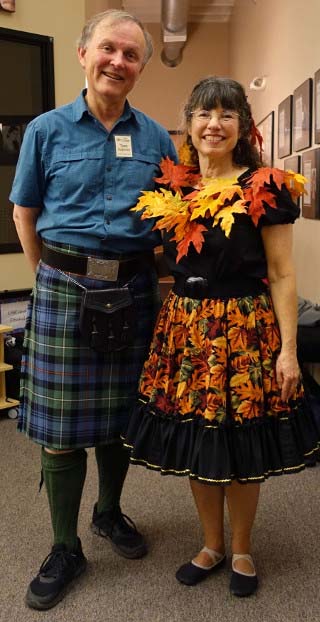 |
Leaves were flying, heels were flying, spirits were flying at our annual Fall Dance on Saturday, October 22 at the Columbia Dance Center. Autumn foliage and pumpkins greeted the dancers,
six of whom were first-timers to a SW WA State Branch dance. The musical stylings of Cynthia Soohoo, Nathaniel Soohoo-Hui, and Alexander Soohoo-Hui inspired flight and elegance in our dancing.
And their Disney-themed set for “It Should Be Fun” brought much laughter and singing along. Here is a short video of our group rocking “Catch the Wind”:
https://www.youtube.com/watch?v=kxtDMeealpc
The dance program was put together by Geri Stuart. Dances were briefed by Linda Mae Dennis and Marge van Nus. Patrick Hogan provided the sound equipment. Linda Lindley devised the decorations. Van Meter Hord welcomed dancers at the door. Other helping hands assisted with set-up and tea. And last, but never least, the scrumptious snacks were provided by all dancers. Thank you one and all for making this a joyous night to remember!
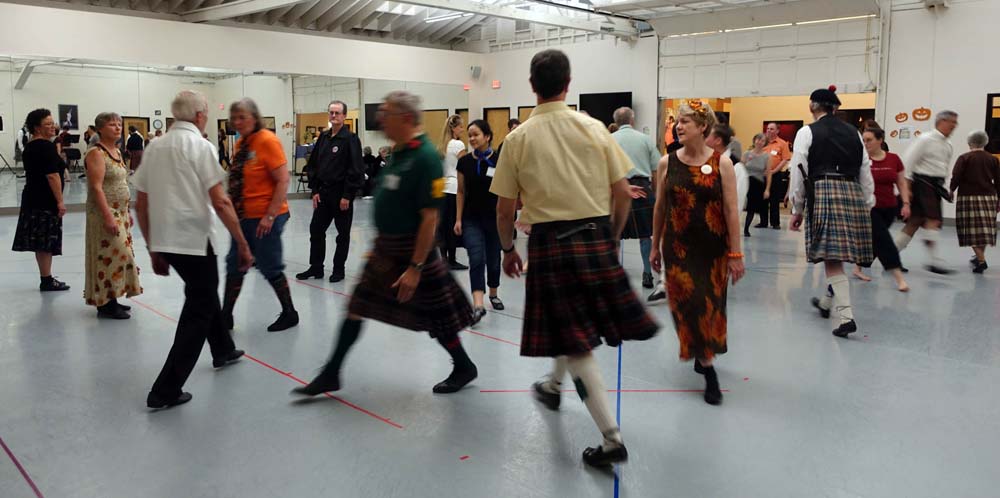
|
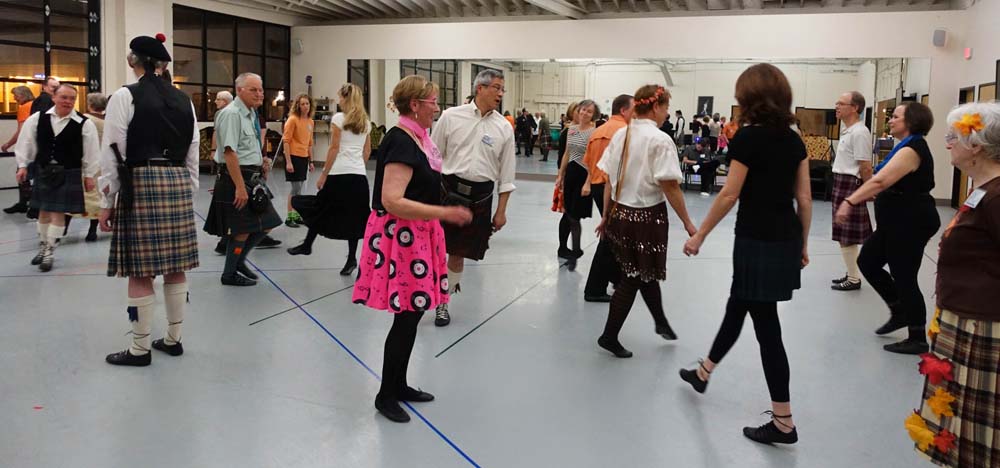
|
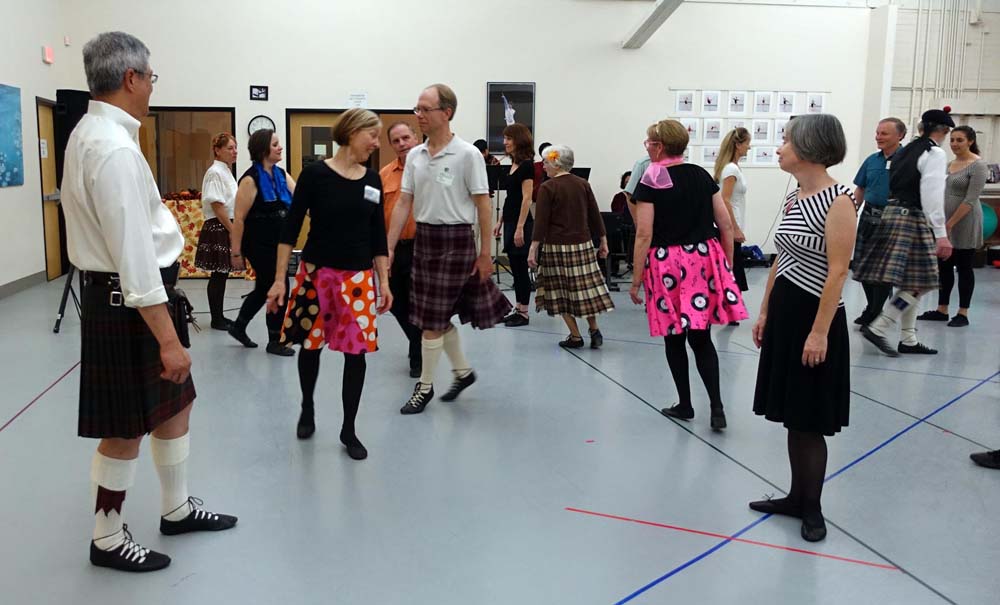
|
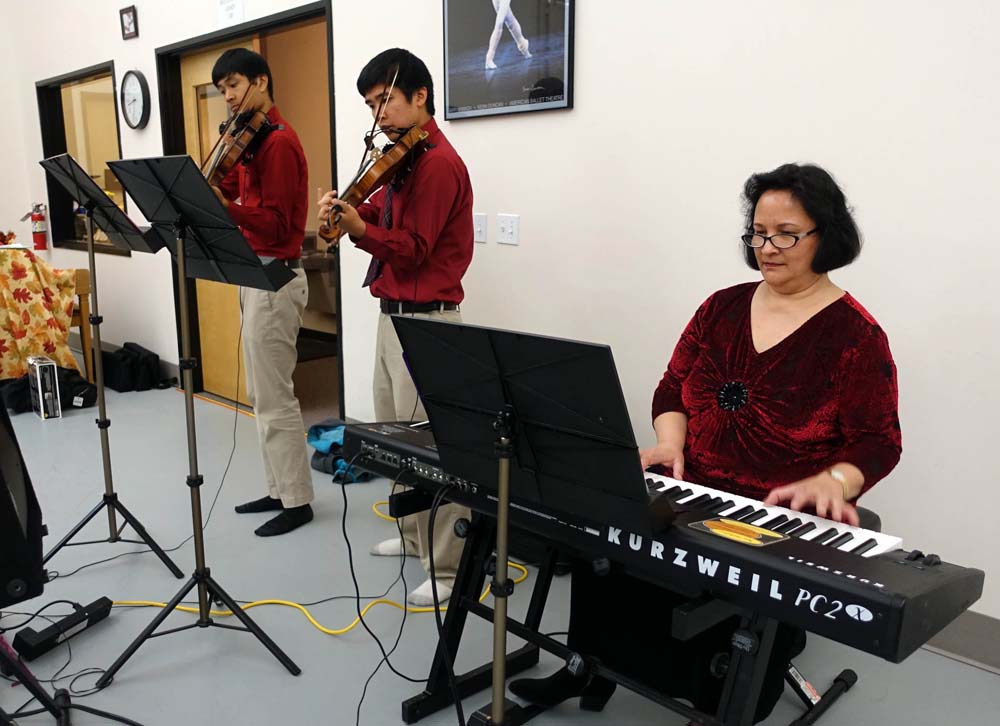
|
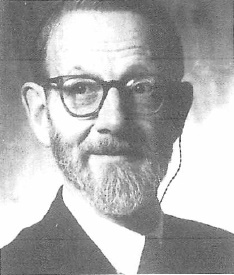 |
Hugh Foss was one of the great dance devisers of the post-war period. With help from Andrew Kellett, Wilson Nicol of London Branch has complied the following article to coincide with the Society's publication of three of his dances with this issue. (Photograph courtesy of John Drewry)
A Chelsea basement!
Hugh Foss started Scottish country dancing in a basement in Chelsea. His wife, Alison, was a Scot and in the early 1930s she took her very English husband to an evening of Scottish Dancing at a friend's house. Hugh sat out the first half and during the interval he was asked what he thought of the proceedings so far. He replied that he was enjoying the dancing, but did not think much of the teaching. At this he was told, probably quite indignantly, that if he could do any better himself he was welcome to try. Not needing a second invitation Hugh read through a book of instructions and by the end of the evening he was in charge. So began his passion for Scottish dance and its music.
Born in Japan
Hugh Foss born in 1902 in Japan, the son of an Anglican missionary bishop, was educated at Marlborough and Cambridge University. He had an immense intellect which he expressed through his dance choreography and in his professional career. He was tall, well over six feet, and lean. As an Englishman he felt he was not entitled to wear a clan tartan so his kilt was the plain grey shepherd's plaid. With grey beard, grey jacket and waistcoat, grey kilt and grey hose he was in appearance a grey man, but his personality and mind were quite the opposite.
Early reprimand!
His impromptu coaching of Scottish dancing that evening in Chelsea came to the notice of the infant London Branch which was concerned by his unauthorised teaching of dances out of the SCDS books. The Committee wrote to Hugh seeking an explanation. He replied that he had meant no harm and had merely explained the dances to a group of enthusiasts. He was unanimously forgiven and invited to join the Branch. Soon he became a regular visitor to the Society's Summer School in St. Andrews.
Precise and logical mind
His wife's friends with whom he started dancing formed the Chelsea Reel Club in 1935. Hugh was its first Vice-Chairman. He became Chairman in 1938 and largely under his tutelage the Chelsea Reel Club flourished. At the same time he was teaching an advanced and a demonstration class on behalf of London Branch. His precise and logical mind meant that his pupils were drilled as to where they should be after every bar of a reel of three. In 1937, he was a member of the first SCDS team to dance overseas - at a Celtic Festival in Brittany, though English Hugh felt he was out of place representing Scotland at such an event. Nor did he accept everything emanating from Society Headquarters. He applied his own thought processes to each ruling and only followed it if it made sense to him.
Leading codebreaker
Hugh Foss was a remarkable but very private man. For obvious reasons he spoke little about his professional career, nor did he reveal much about himself. However a recent book. The Emperor's Codes by Michael Smith, reveals sides of Hugh Foss which his Scottish dancing friends never saw. During the war he was Head of the Japanese Section at Bletchley Park, and in 1942 was awarded the OBE for his work. He was a brilliant codebreaker who played a leading part in cracking Japanese secret ciphers before and during World War II. His first major success was in 1934 when he broke a new machine cipher used by Japanese naval attaches in their embassies. Hugh Foss developed a device to read Japanese machine cipher: it was made in the office using a brown foolscap file cover with a collar stud, a piece of string and slots cut in the cover for the letters. But it worked, and from what we know of Hugh Foss he would not have been worried by its apparent lack of sophistication. In 1944 he was sent to Washington to help American codebreaking work.
While at Bletchley he maintained his interest in Scottish country dancing by running a weekly lunch-time class in the local assembly hall. It was well attended and very lively. After the war he returned to London and in 1947 started the Chelsea Reel Club lntelligencer, Entertainer and Recorder, 'The Crier' . The first issue contained an editorial, a new dance, a description of some Highland setting steps, some verse and a logic puzzle all composed by Hugh. He also resumed his involvement with London Branch. Bill Ireland recalled being fascinated by the neatness of his feet and the intricacy of the steps he executed in the Foursome Reel.
London Branch chairman
In January 1951 Hugh was Chairman of the Branch Committee. He proposed that Branch notices would be more attractive if "issued free to all members the Branch, in the form of a magazine containing other items that would interest or amuse members of the Branch, attract new members or prevent existing members from resigning." Hugh did not speak loudly but he knew how to get his way, and the Committee accepted his offer to edit the proposed magazine himself in May 1951. The first issue of "The Reel" appeared in the following September. The rest is history.
Hugh retired to Glendarroch in Dairy near Castle Douglas. There, his mind could focus fully on the intellectual challenges of choreography. He had dabbled before but now his outpourings increased rapidly, and he became a prolific composer and distributor of modem dances. His advice on choreography was to: "study existing dance figures and invent new ways of developing or combining them and of joining them together; with this for back-ground, and noting the ways in which the music 'can tell you what to do', take good tunes and construct dances to fit them, remembering that each dance must have a personality of its own."
Reputation for frugality
He continued to attend Summer School on a regular basis, taking part in the weekly ceilidhs. Hugh had a reputation for frugality. His shirt cuffs were invariably worn. The same shepherd's plaid kilt he had worn in Brittany in 1937 was still going strong in the 1950s, as Ellen Garvie recalls darning a hole in it then whilst at St Andrews. He also used only one pair of dancing shoes. Each one was numbered '1' or '2'. On the odd days of the month he wore number 1 on his right foot, and on the even days he wore number 2 on his right foot. That way he believed they would wear out evenly and therefore more slowly.
Meticulous
In his later years an inflammation in his legs prevented Hugh from taking an active part in dancing, but he continued to attend St Andrews sitting in class taking characteristically meticulous notes. He died in 1971. His widow, Alison, continued to distribute his dances until the business was taken over by Scottish Dance Archives .
The Emperor's Codes by Michael Smith. ISBN 0-593 0464 1 2. published by Bantam Press.
Marjorie McLaughlin, a teacher from the San Diego, California area who recently taught a workshop in Sisters, Oregon sent us this article and three additional articles written by Hugh Foss whom she knew and is a great fan.
Two are combined in one document Roll Back the Carpet and We Agree to Differ, available in pdf format at
http://www.rscds-swws.org/news/stories/Foss-RollBack-Agree.pdf
The other one is Evolution in Scottish Country Dancing available at
http://www.rscds-swws.org/news/stories/Foss-SCD-Evolution.pdf
~ The Editor
You may click on hypertext links throughout this article in order to learn more information about a topic. ~ The Editor
The Rights and Lefts formation is danced in hundreds of Scottish country dances. When the two-couple formation appears in three-couple dances, one couple is idle and an assymetry sometimes moves the leading couple dancers along different paths into the next formation.
The Arandel formation, pronounced "are-an-dell", is a form of Rights and Lefts for three couples in eight bars. (Can you guess the origin of the name?) The formation is symmetric in a three-couple dance, and the additional activity by a third couple increases the overall dancer activity. The three-couple formation with the leading couple in second place is symmetric Rights and Lefts with potentially improved flow. The first corner dancers are setting, which provides additional variety in either quick-time or strathspey tempo, while the other four dancers dance a pair of Interlocking Rights and Lefts through second place.
Arandel was first introduced and defined in The Scottish Country Dancer newsletter January/February 2015 edition.
 |
An easy dance titled A Plethora of Piñatas features Arandel without the polite turn, and has the leading dancers moving symmetrically and flowing into the next formation with the corner dancers. Click here for the online source. Click here to view a demo.
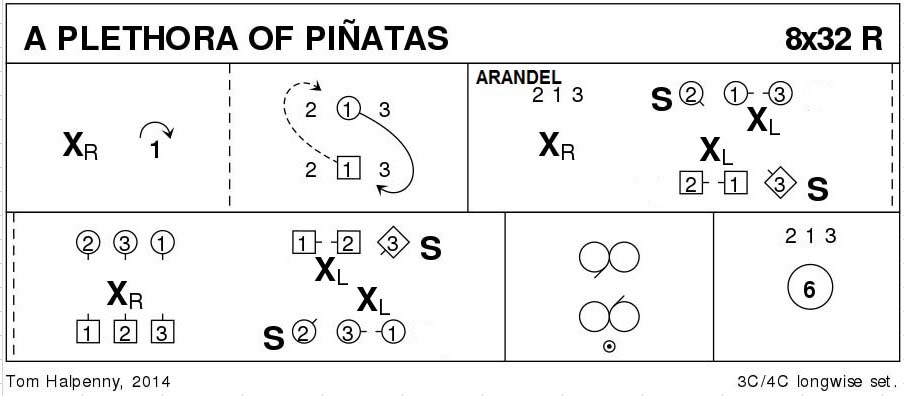 |
Since the original article, this curious dance deviser has analyzed Scottish dances with Rights and Lefts and imagined ideas for dances with Arandel. The first thought that comes to mind is that Arandel can be substituted for Rights and Lefts in many existing dances, since both formations are danced in eight bars. Out of 650 dances in the Scottish Country Dance Database that contain Rights and Lefts, I examined dances that document the choreography with cribs or diagrams.
The Campbell Tyler list of 500 Most Frequent Dances contains ten dances with Rights and Lefts that could be danced with Arandel.
 |
For example, in The Wild Geese the final Rights and Lefts formation leaves 3rd couple idle, whereas Arandel engages 3rd couple.
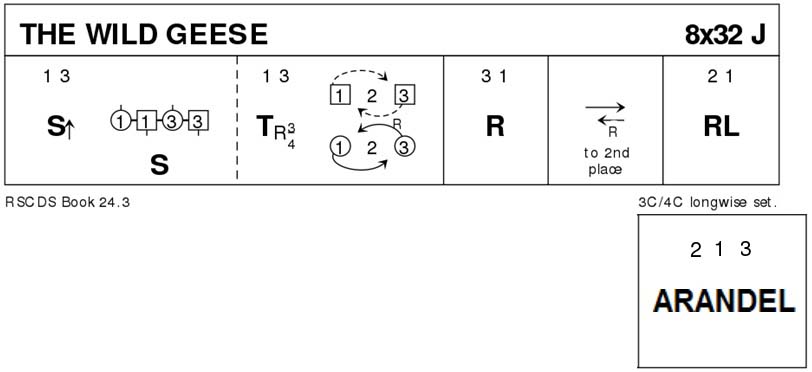 |
Dancing Arandel with 1st couple beginning second place opposite sides finishes with 1st couple between their first and second corners. Omitting the polite turn enables dancers to flow into the next formation with corners.
 |
For example, in Invercauld's Reel, 1st woman finishes Rights and Lefts with polite turn while 1st man omits the polite turn, to face first corners. Compare with dancing Arandel where both dancers omit the polite turn and dance symmetrically to face first corners.
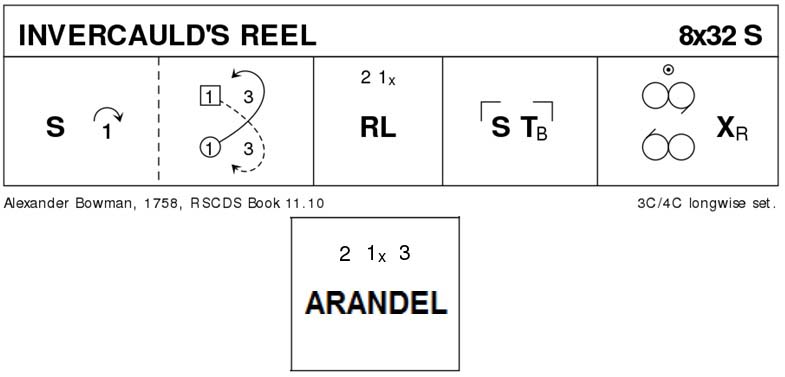 |
Cases to avoid substituting one formation for another formation are:
1. A fundamentally distinct formation. For example, substituting 3-couple Promenade for 2-couple Rights and Lefts
would significantly change the character of a dance. Arandel is fundamentally equivalent to Rights and Lefts,
so it might be acceptable and even desirable to substitute the 3-couple formation.
2. A 3-couple dance that features 2-couple formations. A typical dance has 1st couple dancing with 2nd couple and then
dancing with 3rd couple. Substituting Arandel for 2-couple Rights and Lefts would disrupt the formation balance.
3. A dance with Rights and Lefts that flows into the next formation. For example, Castles In the Air has 1st couple
finish Rights and Lefts to face 3rd couple and dance Half Grand Chain.
The Arandel formation can be extended to five couples with the Interlocking Arandel, which is a form of Rights and Lefts for five couples in eight bars.
 |
For example, in A Flock of Geese the final dual Rights and Lefts formation leaves 4th couple in third place idle, whereas Interlocking Arandel engages 4th couple.
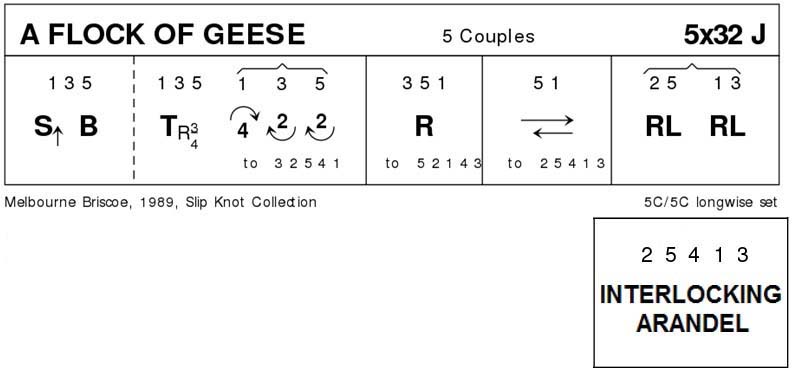 |
Now for the answer to the query about the origin of the name: Liza Halpenny invented the name Arandel = "R and L"!
I generated a list of Scottish Dances with Arandel Formation that includes over 40 additional dances in the SCD Database with Rights and Lefts that can be danced instead with Arandel. The dance titled Captain Ross has first couple moving asymmetrically from Rights and Lefts to Balance In Line with first corners. I substituted Arandel and made some additional changes that interested me, and the resulting new dance is The Infamous El Guapo. Click here for the online source.
Whenever you Scottish dance devisers are introduced to a three-couple dance with Rights and Lefts, think about how you can devise an improved dance with Arandel. Please let me know if you have a dance you would like to share, so I can add your dance name to the list. Thank you! Click the name to email .
Thanks to Keith Rose for providing the dance diagrams and advice. I very much enjoyed accessing the SCD Database, and I would like to thank the hard-working team who have provided the quality data that made this research practical.
Calendar of Events | ||||
|
|